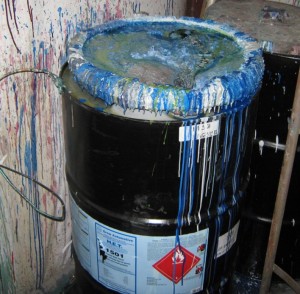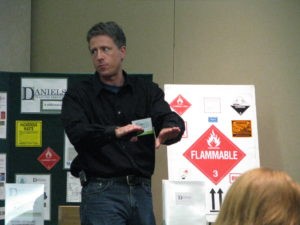Federal regulations of the U.S. Environmental Protection Agency (USEPA) at 40 CFR 262.17(a)(6) require a large quantity generator of hazardous waste (LQG) to comply with the preparedness, prevention, and emergency procedure standards of 40 CFR 262, subpart M. This article is the second in a series that looks closely at each of the sections in subpart M to clearly describe the responsibilities of a LQG.
The purpose of this article is to address the requirements of 40 CFR 262.251 Maintenance and operation of facility.
Before we begin…
These regulations were revised by the Generator Improvements Rule. If your state has not yet adopted the new rule you must continue to comply with the earlier version until it does. You may read an article explaining the earlier version of the regulations (prior to implementation of the Generator Improvements Rule) here.
Not sure of your hazardous waste generator status? |
Scope and Applicability:
These regulations are applicable to a LQG. The requirements of a small quantity generator of hazardous waste (SQG) are exactly the same. If you are a SQG please refer to this article for your version of these regulations: Emergency Preparedness and Prevention for Small Quantity Generator: Maintenance and Operation of Facility.
As made clear by §262.250 (revised by the Generator Improvements Rule), the preparedness, prevention, and emergency procedures of Subpart M are applicable to those areas of a LQG where hazardous waste is generated or accumulated. This includes:
- Central Accumulation Area (CAA)
- Satellite Accumulation Area (SAA)
Read: Applicability of Preparedness, Prevention, and Emergency Procedures for LQG
40 CFR 262.251 reads:
A large quantity generator must maintain and operate its facility to minimize the possibility of a fire, explosion, or any unplanned sudden or non-sudden release of hazardous waste or hazardous waste constituents to air, soil, or surface water which could threaten human health or the environment.
Why the change?
Not much of a change, really. The original opening text of, “Facilities must be maintained and operated…” was changed to reflect the regulations applicability solely to a LQG, “A large quantity generator must maintain and operate…” Other than that, the regulations remain the same as they did before the Generator Improvements Rule. I guess you can’t improve upon perfection!
Interested in site specific training at your site that covers this topic, and more! Ask me about my Onsite Training |
The purpose of these regulations:
This section (§262.251) states the overall goal of subpart M: to prevent damage to human health or the environment due to a release of a hazardous waste. Later in this subpart it details the required equipment, procedures, and actions to take to achieve this goal. In my experience, a performance standard of this sort is used by USEPA to give it a fall-back position for an enforcement action if a facility complies with the letter of the regulations but not its spirit. So, you may be in compliance with the requirements of 40 CFR 262, subpart M but if a hazardous waste release occurs that results in harm to a person or damage to the environment, you may discover that the USEPA accuses you of being in violation of §262.251.
Also, this vague language has been used in the past by states to request actions by generators not – at that time – codified in the regulations, such as posting “NO SMOKING” or “NO IGNITION SOURCES” signs near combustible waste (RO 14036).
Let’s take a closer look at the wording, terms, and phrases used in this section:
“A large quantity generator…” One of the changes made by the Generator Improvements Rule is the codification of these regulations specific to a LQG. A small quantity generator (SQG) must go to §262.16(b)(8) for its version of these regulations while a permitted treatment, storage, and disposal facility (TSDF) must continue to refer to §264, subpart C and D or §265, subpart C and D. Read: What’s the Difference Between Parts 264 and 265 of 40 CFR?
“…must maintain and operate its facility…” This may seem to refer to all aspects of a facility’s maintenance and operation, not just those directly related to the management of hazardous waste, but that is incorrect. §262.250 limits the applicability of the regulations of this entire subpart only to those areas of a LQG where hazardous waste is generated or accumulated on site.
“…to minimize the possibility…” Vague language. It does not require the LQG to prevent an incident but to take steps to minimize the possibility that one may occur.

“…a fire, explosion or…” The concern is not just a spill or release of hazardous waste but fire and explosion as well. And, note the reference to these two emergencies precede any reference to hazardous waste (that comes next). It could be interpreted that you may be held responsible for fires or explosions that occur in applicable areas of your facility even if they are not related to hazardous waste.
“…or any unplanned sudden or non-sudden release of hazardous waste…” Here is the first reference to hazardous waste as a source of an emergency. The release must be unplanned, and thus not part of a permitted discharge to the water or emission to the air. And it may be a sudden or non-sudden release, meaning that it may be the type of catastrophic event you can’t help but notice right away (e.g., an open 55-gallon drum of hazardous waste is knocked over) or something that may take place and go unnoticed over a long period of time (e.g., the slow leak of a hazardous waste from a container or tank).
“…or hazardous waste constituents…” Not limited solely to hazardous wastes but includes the constituents (a component or part of) a hazardous waste. If a hazardous waste were to degrade or leach from your facility in such a way that only the constituents of the original hazardous waste were detected, you would still be in violation of this regulation.
“…to air, soil, or surface water…” Thus a spill that evaporates (release to the air) before it can be recovered is a violation, just as a release to soil or surface water would be. Also to be considered is the vague and subjective distinction between a “release” and a “spill”. Usually a “spill” is an incident where exposure of the spilled material to the environment is minimal and can be quickly recovered. A “release” is typically thought to occur when the spill enters the environment and/or control of it is lost, e.g., it goes down a drain and enters a public sewer system. The defining criteria of a “spill” and “release” may differ by state and individual interpretation.
“…which could threaten human health or the environment.” The final condition of this regulation. Arguably, any fire, explosion, or release as described in this section would not be a violation if it does not threaten human health or the environment. However, this condition is quite subjective, and given the nature of hazardous waste, it is unlikely that any fire, explosion, or release would not threaten either human health or the environment in some way.
Contact me with any questions you may have about the generation, identification, management, and disposal of hazardous waste Daniels Training Services, Inc. 815.821.1550 |
Is that it?
No. First of all, as a LQG you must still comply with the remaining requirements of §262, subpart M as revised by the Generator Improvements Rule.
And then, what about training? At §262.17(b)(7) – directly following the referral to emergency procedures – are the training requirements for a LQG. §262.17(b)(7)(i)(C) reads in part:
At a minimum, the training program must be designed to ensure that facility personnel are able to respond effectively to emergencies…
So clearly, Hazardous Waste Personnel Training at a LQG is important.
